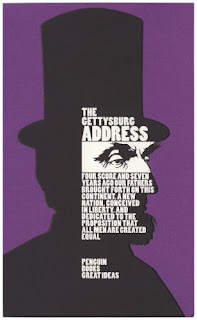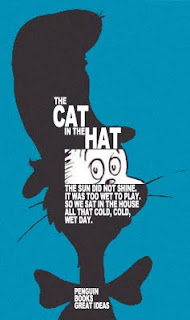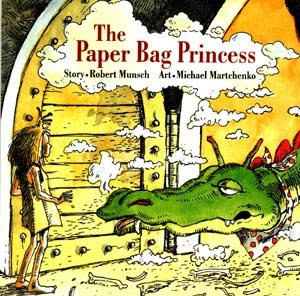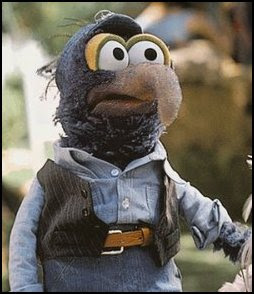I saw this awesome treatment of the Gettysburg Address on the Book Cover Archive Blog:
and I couldn't resist making a new addition to the Penguin Great Ideas Series:
Viewing: Blog Posts Tagged with: Judging a Book By Its Cover, Most Recent at Top [Help]
Results 1 - 5 of 5
Blog: Bottom Shelf Books (Login to Add to MyJacketFlap)
JacketFlap tags: Judging a Book By Its Cover, Book Cover Fun, Add a tag
Blog: Bottom Shelf Books (Login to Add to MyJacketFlap)
JacketFlap tags: Judging a Book By Its Cover, Kids These Days, Old School Classics, Aalphabetical: P, Add a tag

Author: Robert Munsch
Illustrator: Michael Martchenko
The moral of The Paper Bag Princess is a welcome and subversive take on your standard fairy tale fare. A pretty princess loses her clothes and realizes in the end that she doesn't need all those pretty clothes to be a princess. She emerges stronger, more independent, and wielding a new vision of femininity that serves her well as she battles dragons, close-minded boyfriends, and the wedding industry.
Unfortunately, I think the message of this book may have been too subtle because the moral seems to have been lost on some of our modern day princesses. Whereas the original Paper Bag Princess shed her clothes in a bold act of defiance, bravely discarding the trappings and confines of traditional femininity, today's female royalty are shedding their clothes for an entirely different reason.
The phenomenon was thoroughly examined in Ariel Levy's Female Chauvinist Pigs: Women and the Rise of Raunch Culture, and will be further explored in Almeta Grayson's new book Paper Bag Princess, which profiles the disturbing trend of sexual exploitation as a route to fame. (exhibit A: Paris Hilton; exhibit B: Kim Kardashian). From Publishers Weekly: "These sobering portraits force the reader to question a society that not only encourages this brand of sexploitation, but rewards it with prime time TV deals and endless magazine covers. A well-balanced but jarring social critique, Paper Bag Princess will change the way you watch TV... and how you see the world."
From Publishers Weekly: "These sobering portraits force the reader to question a society that not only encourages this brand of sexploitation, but rewards it with prime time TV deals and endless magazine covers. A well-balanced but jarring social critique, Paper Bag Princess will change the way you watch TV... and how you see the world."
Note: This started out as a standard satirical post, but I have to admit that I am legitimately disturbed by this. Maybe it's because I'm getting to the age where the idea of fatherhood is not just a distant and abstract concept, but I consistently find myself flipping through the TV saying to myself (or my wife), "Our children will not watch TV. We are moving to a remote cabin in the woods where E! cannot find us." Call me a prude, but the idea of raising a daughter in a world where sex tapes are a legitimate path to stardom scares the sh!t out of me.
A Lighter Note: For a more thorough discussion of the actual Paper Bag Princess, see Fuse #8's profile of the book, which came in at #70 in her Top 100 Picture Books List.
Blog: Bottom Shelf Books (Login to Add to MyJacketFlap)
JacketFlap tags: Aalphabetical: E, Bizarre, Judging a Book By Its Cover, Miscellaneous, Judging a Book By Its Cover, Bizarre, Aalphabetical: E, Add a tag
I found this interesting review on Amazon.com:
162 of 175 people found the following review helpful:
2.5 out of 5 stars I AM NOT A MONSTER!!! January 30, 2008
By Gonzo the Great "Creative Consultant" (Reno, Nevada) See all my reviews First let me say that I have great respect for Ed Emberley... but as a weirdo, I felt that it is my duty to say something. People have been making this mistake for far too long... so listen up: Weirdos are not Monsters!!!!
First let me say that I have great respect for Ed Emberley... but as a weirdo, I felt that it is my duty to say something. People have been making this mistake for far too long... so listen up: Weirdos are not Monsters!!!!
Just look at Emberley's list of so-called "weirdos": Vampire, Goblin, Cat, Monster, Witch, Devil, etc. As you can see, these are monsters, not weirdos. (Except for the cat... because cats are most definitely weird).
Now I'm not saying that weirdos can't be monstrous, because they can. And I'm definitely not saying monsters can't be weird cause there are some doozies out there (take this guy for example).
When it comes down to it, I'm not even sure exactly what weirdos are... but that's beside the point! My point is that weirdos are not necessarily monsters! So, basically, if Emberley changed the name of his book to Ed Emberley's Little Drawing Book of Monsters (Who Also Happen to be Weirdos), then I'd have no problem with it. In fact, I'm tempted to buy it anyways because I can get a used one for only 99 cents... and offensive or not, that's a bargain!!!
Blog: Bottom Shelf Books (Login to Add to MyJacketFlap)
JacketFlap tags: Wild Animal Kingdom, Judging a Book By Its Cover, Aalphabetical: H, Wild Animal Kingdom, Judging a Book By Its Cover, Aalphabetical: H, Add a tag

The Construction of Meaning and the Self De(con)struction of Identity: A Hippo-Critical Analysis of Jeff Newman's Hippo! No, Rhino!
Rosco P. Hargrove (Class of 2010)
English 421: Re-Introduction to Literary Criticism
Professor F. R. Zismer
Final Paper
Submitted on: December 22, 2007
Plot Summary
A mischievous zookeeper decides to have some fun and puts a sign that reads "Hippo" in front of the Rhino pen. This seemingly harmless bit of mischief wreaks havoc on the rhino's psyche as passersby continually refer to the rhino as "hippo". The rhino desperately tries to correct them, but to no avail. It isn't until a little boy comes along that things change. The child sees what's going on and changes the sign back to rhino. The book ends with the zookeeper continuing his mischievous ways by putting up a new sign that reads, "Porcupin-o".
Part I: Hippo! No, Rhino! Structuralism! No, Poststructuralism!
Newman's sparse use of language is deceptive. While he uses few words in his narrative, he manages to reveal deeper linguistic issues by drawing together some of the fundamental issues and conflicts in literary criticism.
As a starting point, the basic conflict in Hippo! No, Rhino! is clearly a re-creation of the tension between the structuralist and post-structuralist schools of thought. Newman's Hippo! No, Rhino! situation is an intriguing thought exercise which forces us to reconsider a fundamental question: Where does meaning come from?
Is it from the zookeeper (filling the archetypal role of trickster-god) who creates meaning by labeling the rhino as "hippo"? Or is his semantic subversion just a silly prank?
Is it the people reading the sign who give birth to meaning by creating the link between the sign ("hippo") to the signified (the rhino)? Or are they merely dimwitted automatons who will believe anything they read?
Is there even any meaning to begin with? Who are we (or the rhino) to say that "rhino" is the correct label? Isn't the polyphonic spree of letters and sounds that make up r-h-i-n-o ultimately as arbitrary as h-i-p-p-o?
Part II: Pedagogy of the Zoopressed
If we continue to peel away layers of this onion, we eventually find ourselves alone with the tear-jerkingly tragic figure of the "rhino".
(Note: Though it is awkward, I will refer to the rhino using the pronoun "it" because Newman's text does not indicate whether the rhino is male or female.)
(Full disclosure: Upon first reading, I subconsciously assumed that the rhino was a male, which tipped my hand as an unwitting co-conspirator in the phallocentricity embedded in our male-dominated society. I would like to assure you, professor, that based on last semester's readings on feminist theory and gynocritic analysis, I am sufficiently ashamed.)
Why is the rhino a tragic figure? Not only because it is helplessly tormented by the powerful zookeeper... that is but a minor offense. The true tragedy reveals itself with further examination of the sociolinguistic context of the rhino's self-identification.
The word "rhino," being of English (Anglo-Saxon) origin is obviously not the rhino's native tongue. Yet the rhino has come to identify itself as a "rhino," as evidenced by the psychological distress caused by the hippo sign. This self-identification through the language of his oppressor (and yes, he is oppressed... he is, after all, held captive and put on display) is one of major symptoms of oppression that is revealed by postcolonial theory.
The fact that the rhino clings so passionately and desperately to the name bestowed upon him by his captors, demonstrates the powerful role that language plays in perpetuating the inequalities of established social hierarchy. Not only does he accept his given name, he challenges anyone who dare disrupt the sanctity of his moniker. How can the rhino truly free itself from oppression if it lives, breathes, and thinks in the language of its oppressor?
This also sheds new light on the character of the child. As I mentioned in the plot summary, toward the end of the book a young child comes to the rescue, changing the hippo sign back to rhino.
Upon first reading, the child appears as a saviour figure who sympathetically changes the sign to ease the "rhino's" mind. The child's innocence allows him to see beyond the ridiculous sign and recognize the psychological harm being done to the rhino. And yet...
...and yet, perhaps it is not that simple. By reverting the sign (the linguistic tool of oppression), isn't the child merely reinforcing the domination of the status quo and strengthening the establishment's vice-like grip on society? The child may have acted to ease the rhino's mind but (despite the child's benelovent intentions), in actuality he played an active role in relegating the beast to an eternity of tranquil captivity. He did not rescue the rhino, he merely made his cage stronger.
Part III: Freedom Isn't Free or All Signs Point to "No"
Newman's stimulating text leaves the reader (at least this reader) with a final burning question... Who holds the key to the rhino's freedom?
The optimist's answer would be that the key to freedom lies with the rhino itself. Unfortunately, to quote Karl Marx, "Religion is the opium of the masses and optimism is the ecstasy tablet of the self-delusional." So no, the rhino does not hold the key to his own freedom.
The real answer is much simpler and much more sobering. The key to freedom lies with: the zookeeper. (Seriously, it's on the big key ring that's clipped to his belt buckle.)
This does not bode well for the rhino. At the end of the book, the zookeeper puts up a new sign next to the rhino that reads, "Porcupin-o". In doing so, this sadistic trickster god is assuring us that the rhino's nightmare is not over... and that no amount of lit crit is going to save him from an eternity in this semiotic purgatory. The helpless rhino (like the rest of us) is forever caught in that desolate place between meaning and just plain mean.
Blog: Saipan Writer (Login to Add to MyJacketFlap)
JacketFlap tags: Saipan, CNMI, Labor, Minimum wage, cost of living, Add a tag
If the new minimum wage went into effect immediately, an hour of work would buy a gallon of gasoline (well, except for taxes paid on the "earnings"). But it doesn't go into effect until July. So for now, an hour of work is not enough, even if there weren't income tax, for this basic purchase.



Perfect. Absolutely perfect.
thanks, MR! I had a feeling that you'd appreciate that...
Absolutely love it!